 |
JAVA: Multithreading 2 |
| << JAVA: Multithreading 1 |
| JAVA Web Application Development >> |

Web
Design & Development CS506
VU
Lesson
24
More on
Multithreading
In
this handout, we'll cover
different aspects of multithreading.
Some examples are given to
make you
understand the
topic of multithreading. First we
will start with an example
that reads data from
two text
files
simultaneously.
Example
Code: Reading Two Files
Simultaneously
The
task is to read data from
file "first.txt" & "second.txt"
simultaneously. Suppose that
files contains the
following
data as shown below
first.txt
second.txt
Following
is the code for ReadFile.java
that implements Runable
interface. The file reading
code will be
written
inside the run( ) method.
//
File ReadFile.java
import
java.io.*;
public
class ReadFile implements
Runnable{
//attribute
used for name of
file
String
fileName;
//
param constructor
public
ReadFile(String fn){
fileName
= fn;
}
//
overriding run method// this
method contains the code for file
reading
public
void run ( ){
try
{ //
connecting FileReader with
attribute fileNameFileReader fr =
new
FileReader(fileName);BufferedReader
br = new BufferedReader(fr);
String
line = "";
//
reading line by line data
from file// and displaying it on
console
line
= br.readLine();
while(line
!= null) {
System.out.println(line);
line
= br.readLine();
}
fr.close();
br.close();
}catch
(Exception e){
System.out.println(e);
}
} //
end run() method
} //
File Test.java
public
class Test {
public
static void main (String
args[]){
//
creating ReadFile objects by passing
file names to them
ReadFile
first = new
ReadFile("first.txt");
ReadFile
second = new
ReadFile("second.txt");
175
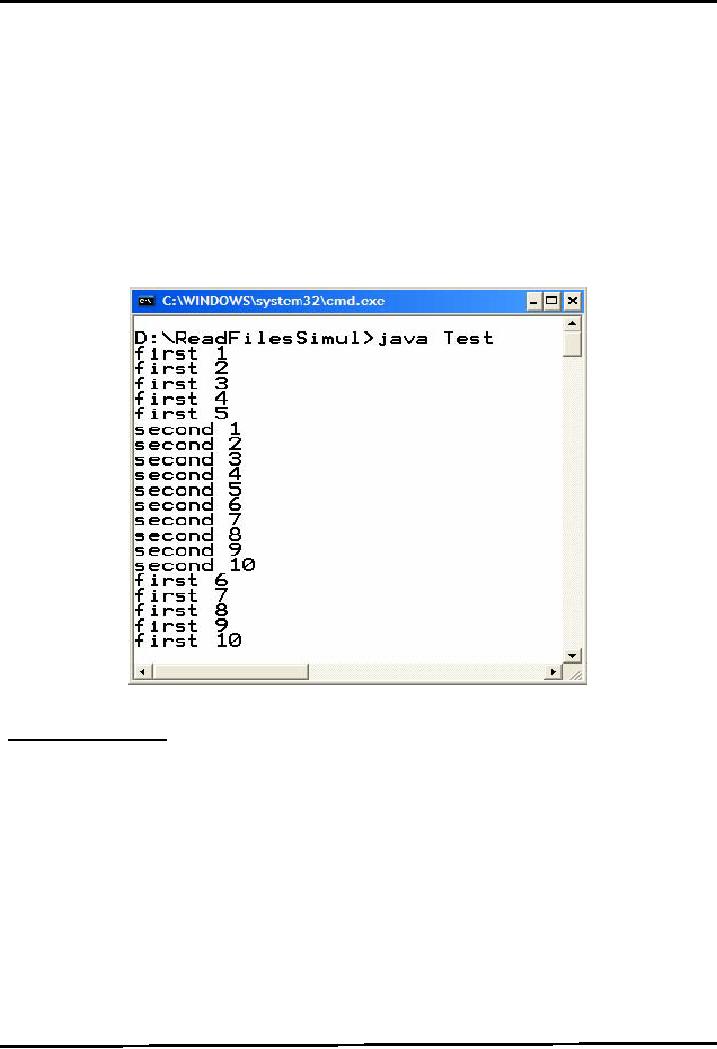
Web
Design & Development CS506
VU
//
Instantiating thread objects and
passing
//
runnable (ReadFile) objects to
them
Thread
t1 = new Thread(first);
Thread
t2 = new Thread(second);
//
starting threads that cause
threads to read data
from
//
two different files
simultaneously
t1.start();
t2.start();
}
}
Output
On
executing Test class,
following kind output would
be generated:
Now
let's discuss some useful
thread class methods.
. sleep(int
time) method
-Causes
the currently executing thread to wait
for the time (milliseconds)
specified
-Waiting
is efficient equivalent to non-busy.
The waiting thread will not
occupy the processor
-Threads
come out of the sleep when
the specified time interval
expires or when interrupted by
some
other
thread
-Thread
coming out of sleep may go
to the running or ready state
depending upon the availability of
the
processor.
The different states of
threads will be discussed
later
-High
priority threads should
execute sleep method after
some time to give low
priority threads a
chance
to run otherwise starvation
may occur
-sleep() method
can be used for delay
purpose i.e. anyone cal
call Thread.sleep()method
-Note
that sleep() method can throw
InterruptedException. So, you
need try-catch block
Example
Code: Demonstrating sleep ( )
usage
Below
the modified code of Worker.java is
given that we used in the
previous handout.
//
File Worker.javapublic class
Worker implements Runnable
{
private
String job ;
//Constructor
of Worker class
public
Worker (String j ){
176

Web
Design & Development CS506
VU
job =
j;
}
//Implement
run()
method of
Runnable
interface
public
void run ( ) {
for(int
i=1; i<= 10; i++)
{
try {
Thread.sleep(100); // go to sleep for 100
ms}catch
(Exception
ex){System.out.println(ex);}
System.out.println(job
+ " = " + i);} // end for} // end
run }
// end class
//
File SleepEx.java
public
class SleepEx {
public
static void main (String args[
]){
//
Creating Worker objects
Worker
first = new Worker ("first
job");
Worker
second = new Worker ("second
job");
//
Instantiating thread class objects
Thread
t1 = new Thread (first
);
Thread
t2 = new Thread (second);
//
starting thread
t1.start();
t2.start();
}
} //
end class
Output
On
executing SleepEx.java, the output
will be produced with exact alternations
between first thread &
second
thread. On starting threads, first thread
will go to sleep for 100
ms. It gives a chance to
second
thread to execute.
Later this thread will also
go to sleep for 100 ms. In
the mean time the first thread
will
come
out of sleep and got a
chance on processor. It will
print job on console and
again enters into
sleep
state
and this cycle goes on until
both threads finished the
run() method
Before
jumping on to example code, lets
reveal another aspect about
main() method. When you
run a Java
program,
the VM creates a new thread and
then sends the main(String[]
args) message to the class to
be
run!
Therefore, there is always at least
one running thread in existence. However,
we can create more
177
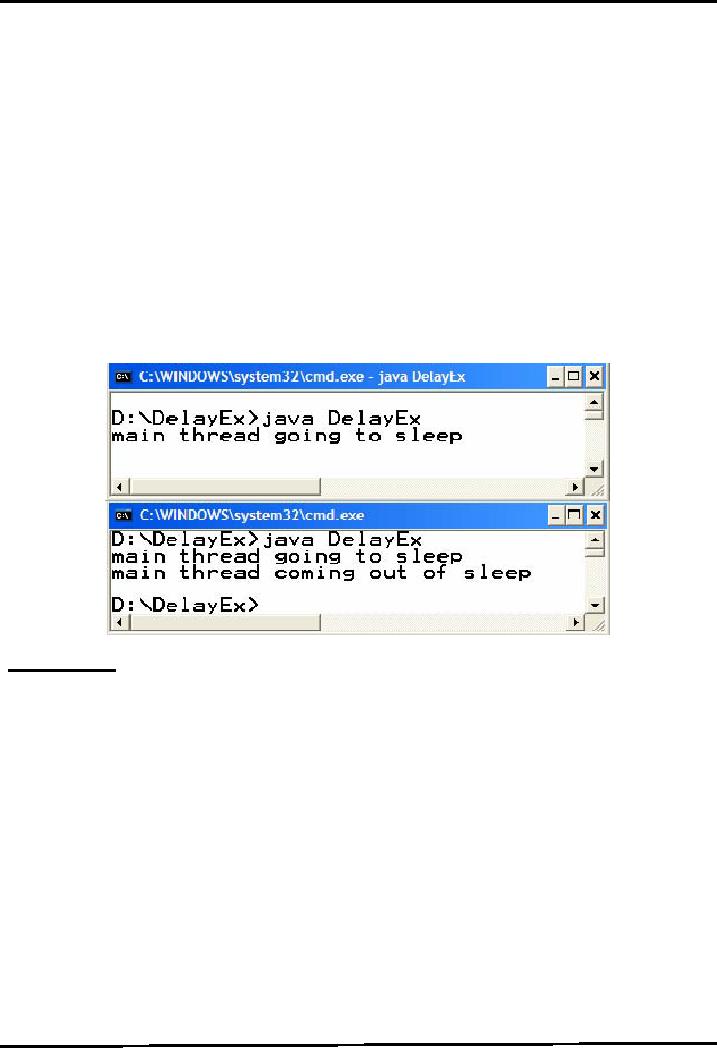
Web
Design & Development CS506
VU
threads
which can run concurrently
with the existing default
thread.
sleep() method
can be used for delay
purpose. This is demonstrated in the
DelayEx.java given
below
//
File DelayEx.java public
class DelayEx { public static
void
main
(String args[ ]){ System.out.println("main thread
going
to
sleep");
try
{
// the
main thread will go to sleep causing
delay
Thread.sleep(100);
}catch (Exception
ex){
System.out.println(ex);
}
System.out.println("main
thread coming out of sleep"); } // end
main() }
//
end class
Output
On
executing DelayEx class, you
will experience a delay after the
first statement displayed.
The second
statement
will print when the time
interval expired. This has
been show below in the following
two
diagrams:
. yield(
) method
-Allows
any other threads of the
same priority to execute (moves
itself to the end of the priority
queue)
-If
all waiting threads have a
lower priority, then the
yielding thread resumes execution on
the
CPU
-Generally
used in cooperative scheduling
schemes
Example
Code: Demonstrating yield ( )
usage
Below
the modified code of Worker.javais
given
//
File Worker.javapublic class
Worker implements
Runnable
{ private String job
;
//Constructor
of Worker class
public
Worker (String j ){
job =
j;
}
//Implement
run()
method of
Runnable
interface
public
void run ( ) {
for(int
i=1; i<= 10; i++)
{
//
giving chance to a thread to execute of
same priority
178
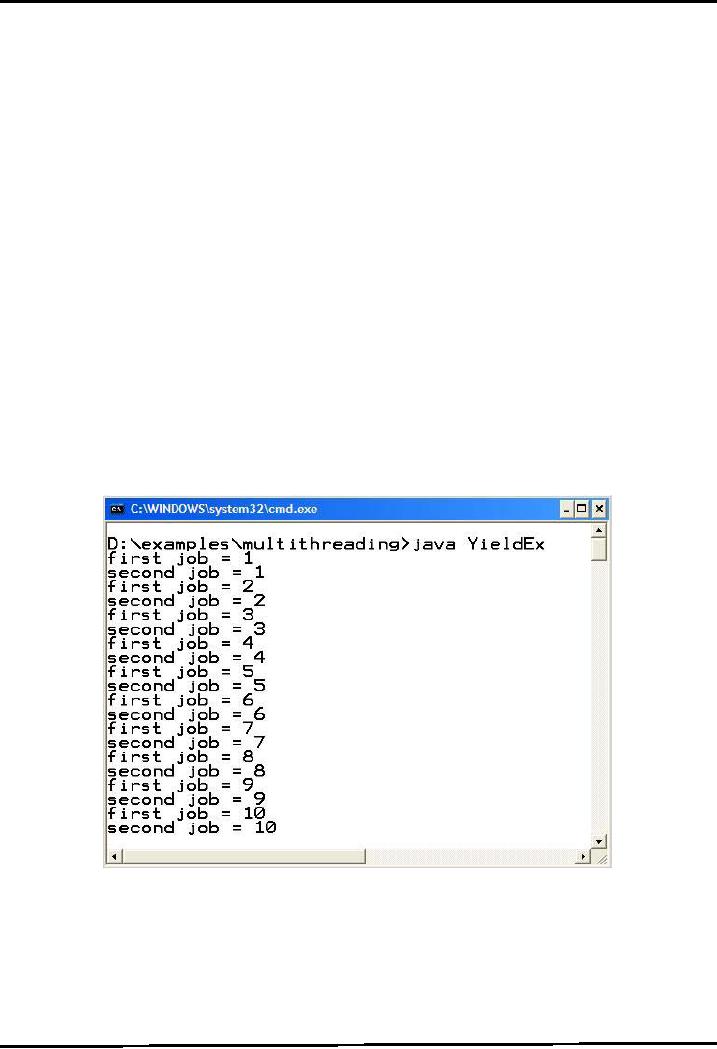
Web
Design & Development CS506
VU
Thread.yield(
);
System.out.println(job
+ " = " + i);
} // end
for
} // end
run
} // end
class // File
YieldEx.java
public
class YieldEx {
public
static void main (String args[
]){
//
Creating Worker objects
Worker
first = new Worker ("first
job");
Worker
second = new Worker ("second
job");
//
Instantiating thread class objects
Thread
t1 = new Thread (first
);
Thread
t2 = new Thread (second);
//
starting thread
t1.start();
t2.start();
}
} //
end class
Output
Since
both threads have the same
priority (until we change the
priority of some thread explicitly).
Therefore
both
threads will execute on
alternate basis. This can be
confirmed from the output
given below:
A thread
can be in different states
during its lifecycle as shown in the
figure.
179
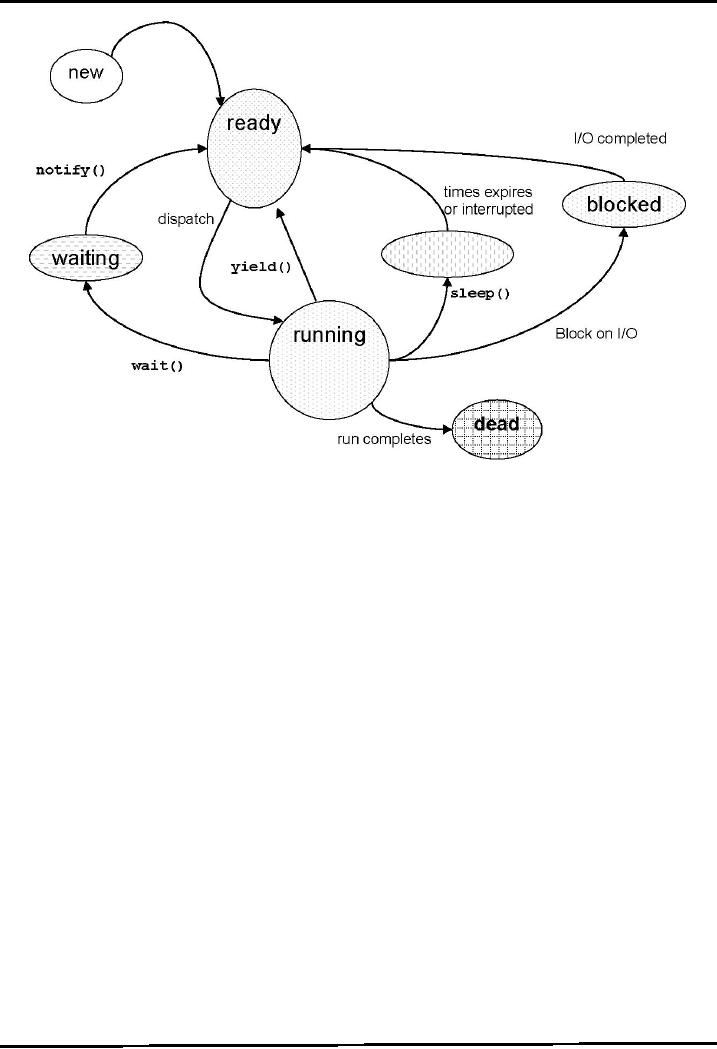
Web
Design & Development CS506
VU
180
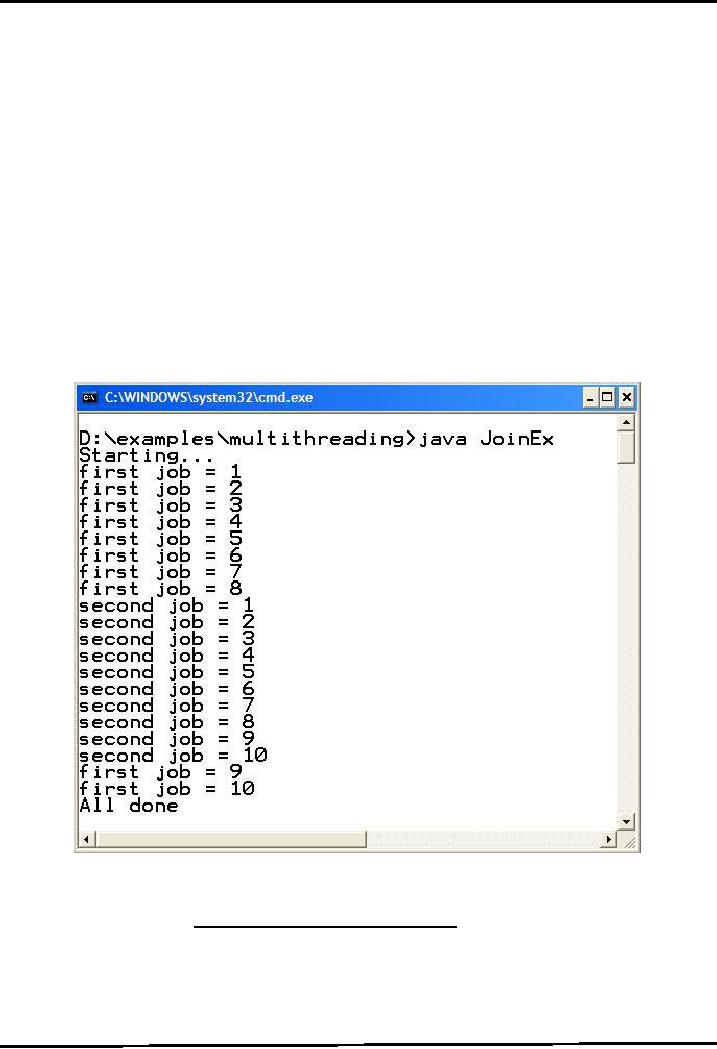
Web
Design & Development CS506
VU
Thread
t2 = new Thread (second);
System.out.println("Starting...");
//
starting threads
t1.start();
t2.start();
//
The current running thread
(main) blocks until both
//workers have finished
try
{
t1.join();
t2.join();
}catch (Exception
ex) {System.out.println(ex);}
System.out.println("All
done ");
} // end
main}
Output
On
executing JoinEx, notice
that "Starting" is printed
first followed by printing
workers jobs. Since
main
thread do
not finish until both
threads have finished their
run( ). Therefore "All done"
will be print on last.
References:
Java,
A Practical Guide by Umair
Javed
Java
tutorial by Sun:
http://java.sun.com/docs/books/tutorial/
CS193j
handouts on Stanford
181
Table of Contents:
- JAVA FEATURES
- Java Virtual Machine & Runtime Environment
- Learning Basics of JAVA
- JAVA: Object Oriented Programming
- JAVA: Inheritance
- JAVA: Collections
- JAVA: Intro to Exceptions
- JAVA: Streams
- JAVA: Modification of Address Book Code
- JAVA: Graphical User Interfaces
- JAVA: Event Handling
- JAVA: More Examples of Handling Events
- JAVA: Problem in Last Code Example
- Java Database Connectivity
- JAVA: More on JDBC
- JAVA: Result Set
- JAVA: Meta Data
- Java Graphics
- JAVA: How to Animate
- JAVA Applets
- JAVA: Socket Programming
- JAVA: Serialization
- JAVA: Multithreading 1
- JAVA: Multithreading 2
- JAVA Web Application Development
- Java Servlets
- JAVA: Creating a Simple Web Application in Tomcat
- JAVA: Servlets Lifecycle
- JAVA: More on Servlets
- JAVA: Dispatching Requests
- JAVA: Session Tracking 1
- JAVA: Session Tracking 2
- JAVA: AddressBook Case Study Using Sevlets
- Java Server Pages 1
- JavaServer Pages 2
- Java Server Pages 3
- JAVA: JSP Action Elements and Scope
- JAVA: JSP Custom Tags
- JAVA: MVC + Case Study
- JAVA: MVC Model 2 Architecture
- JAVA: Layers and Tiers
- JAVA: Expression Language
- JAVA: JavaServer Pages Standard Tag Library (JSTL)
- JAVA: Client Side Validation & JavaServer Faces (JSF)
- JAVA: JavaServer Faces